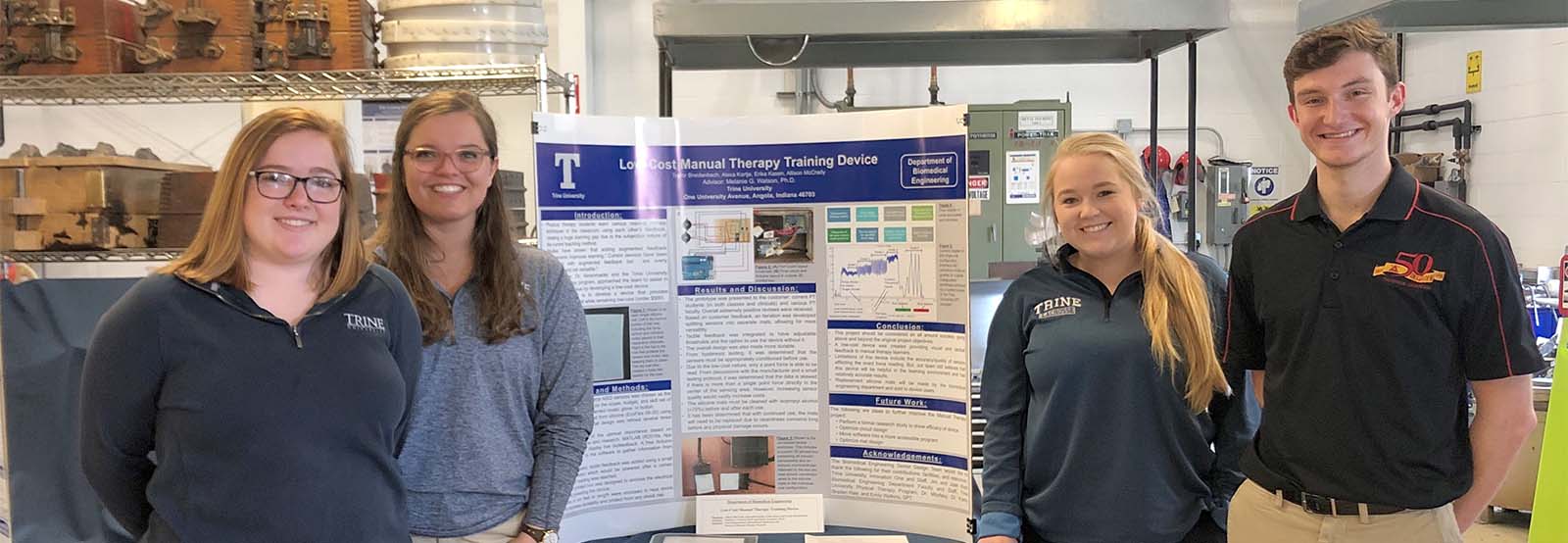
Tusk: Fleetwood Mac tribute coming to Trine Nov. 17
Tusk, the Ultimate Fleetwood Mac Tribute, will bring the band’s greatest hits to the stage of Trine University’s T. Furth Center for Performing Arts on Friday, Nov. 17.
May 13, 2019

A collaboration between engineering students at Trine University’s main campus and faculty and students from the university’s Health Sciences Education Center in Fort Wayne has resulted in a device that will assist training for Doctor of Physical Therapy students.
The senior design project team of Allison McCrady, a biomedical engineering major from Lancaster, Ohio, Taylor Breidenbach, a mechanical engineering from Brownsburg, Indiana, Erika Kasen, a biomedical engineering major from Hudsonville, Michigan, and Alexandra Kartje, a biomedical engineering from Valparaiso, Indiana, developed a low-cost system that captures the forces applied by physical therapy students when performing hands-on “manual therapy” techniques, providing real-time feedback to students and instructors.
“We were presented four projects, (and) this project interested us the most,” said McCrady. “It had more of a clinical aspect and the solution seemed achievable. Additionally, we all are more mechanically focused, so we chose a more mechanical project rather than a chemically based project.”
“Physical therapy students really struggle to learn how much force to apply with different types of techniques,” said Thomas “Gus” Almonroeder, Ph.D., assistant professor in the Rinker-Ross School of Health Sciences, who facilitated the project. “They don't really know how much force they are applying and they also can't observe how much force their instructors are applying. Typically they are told to try to feel for changes in resistance in order to modulate the forces they apply, but it can be tough for beginners.”
After receiving some initial guidance from Almonroeder, the group met with Max Baumgartner, Ph.D., dean of the Rinker-Ross School of Health Sciences, and others in the Department of Physical Therapy. Baumgartner suggested the group use sensors that could be directly placed on a person for more authentic training.
“This turned out to be really great advice and helped to get the project headed in a good direction,” said Almonroeder.
Emily Watkins, who graduated this spring from Trine’s Doctor of Physical Therapy program, also met with the group multiple times during the later phases to provide feedback about their design.
“The engineering students also gave a demo of their system to students and faculty in the physical therapy program and some local clinicians, which was also very helpful,” said Almonroeder.
The group initially developed four design concepts: a mat, a glove, an instrumented model and a button. After conducting a design analysis, they determined the force-sensing mat would best fit the needs of physical therapy students.
Discovering through research that augmented feedback improves learning, the team added vibration motors to the force-sensing mat, allowing the system to give feedback via touch as well as through a visual display.
“It was really impressive to see what they designed. The system they developed really surpassed my expectations or what I could have done,” Almonroeder said. “They demonstrated really exceptional skills and also great persistence throughout the project. I am very proud of their efforts.”
The mat platform will be given to the Department of Physical Therapy for future use in the classroom.
“Our hope is that the device will help future PT students learn manipulative therapy better and faster,” said McCrady.
“It was a really fun project for me to be associated with,” said Almonroeder. “Lots of people with different perspectives, skill sets, etc. That's usually a recipe for a good product.”